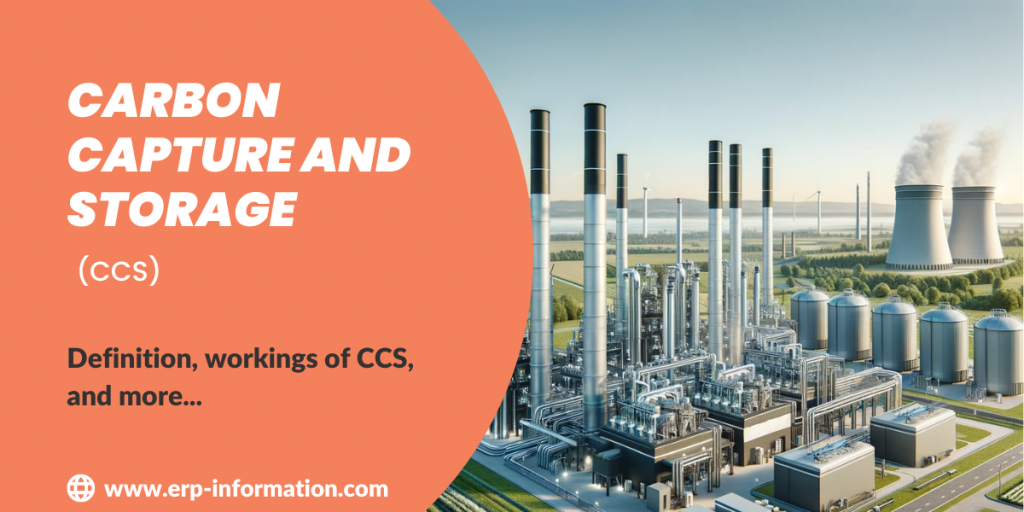Carbon capture and storage technologies play an important role in mitigating carbon dioxide (CO2) emissions by capturing and utilizing or storing them deep below the Earth’s surface.
In this post, you will learn about CARBON CAPTURE AND STORAGE TECHNOLOGY in detail.
What does it do?
- CCS technology captures carbon dioxide (CO2) emissions produced from the use of fossil fuels in electricity generation and industrial processes.
- The captured CO2 undergoes concentration through chemical or biological processes, serving either as a valuable feedstock or being securely stored underground. This proactive measure prevents CO2 emissions from industrial activities, contributing to the stabilization of CO2 levels in the atmosphere.
- The concentrated CO2 offers carbon-neutral alternatives for industries like oil and gas, aviation, construction, and chemicals, acting as a sustainable feedstock.
- Simultaneously, CO2 storage solutions leverage depleted oil or gas fields and saline formations, providing environmentally responsible options for the long-term storage of carbon dioxide.
How does carbon capture and storage work?
CCS works in three methods
- Post-combustion capture method
- Pre-combustion capture method
- Oxyfuel technology method
Post-combustion capture method
- Utilizes absorption or membrane-based methods to remove CO2 from flue gases emitted during fossil fuel combustion.
- Involves ‘scrubbing’ techniques to capture CO2 after combustion.
- Commonly used in existing power plants to retrofit carbon capture technology.
Pre-combustion capture method
- Removes CO2 before combustion by employing processes like steam methane reforming or gasification of fuels (coal or biomass).
- Generates syngas, which undergoes a water-gas shift reaction to produce hydrogen and concentrated carbon dioxide.
- Enables the production of blue hydrogen, where hydrogen is the main product and carbon dioxide is captured.
Oxyfuel technology method
- Burns fuel using pure oxygen or a mix of oxygen and recirculated flue gas instead of air.
- Offers advantages such as reduced fuel consumption, higher flame temperature, and lower heat loss.
- Results in a concentrated CO2 stream, facilitating easier carbon capture and sequestration.
- Allows for the capture of heat released during condensation, contributing to overall efficiency.
- Achieves a 75% reduction in overall flue gas volume compared to air combustion.
Advantages of oxyfuel combustion
- Reduced fuel consumption: Oxyfuel combustion enhances combustion efficiency, leading to lower fuel requirements.
- Higher flame temperature: The use of oxygen increases flame temperatures, improving thermal efficiency.
- Less heat loss: Oxyfuel technology minimizes heat losses during combustion, optimizing energy utilization.
- Greater CO2 concentration: Results in a concentrated CO2 stream, simplifying the carbon capture and storage process.
- Condensable flue gas: Facilitates easier compression separation due to the greater condensability of the flue gas.
- The capture of heat of condensation: Allows for the capture and utilization of the heat released during the condensation process.
- 75% Reduction in the overall flue gas: Significantly reduces the volume of flue gas, streamlining the carbon capture process.
Where are carbon emissions stored in CCS?
Case study
The Citronelle Project showcased an integrated approach, capturing CO2 from a pulverized coal-fired facility. The compressed CO2 was transported via a dedicated 12-mile pipeline to a saline storage site southeast of Citronelle, Alabama.
The injection into a saline formation overlying the Citronelle oilfield demonstrated the potential of saline storage alongside oil field operations.
Citronelle has also become a testing ground for innovative fiber optic cable technologies, including distributed temperature and acoustic sensing. The project holds promise for future development, particularly in the Gulf Coast Reservoir.
Worldwide status of CCS
This ambitious goal necessitates a significant increase in investments across all sectors and in various near-zero emissions technologies.
Notably, the data on carbon capture and storage (CCS) investments reflects a substantial rise, with the total capacity of CCS projects in development, reaching 244 million tonnes per annum (Mtpa) of carbon dioxide (CO2) as of September 2022—an impressive 44% increase over the past year.
Government policies and regulations are also evolving, strengthening the business case for CCS investment. The business community is increasingly recognizing CCS as a critical tool to mitigate exposure to CO2 emissions and, for some, an opportunity to participate in a growing industry.
Governments worldwide are reinforcing policies to encourage private-sector investment in CCS.
In North America, Europe, and the UK, established leaders in CCS-relevant policies have maintained or strengthened their positions.
The US, for instance, passed the “Infrastructure Investment and Jobs Act“, allocating over US$12 billion for CCS-related activities. Canada and European countries have introduced tax credits and subsidies to support CCS projects, signaling a commitment to fostering a low-carbon future.
While North America and Europe are leading in climate and CCS policies, the Asia-Pacific region is making notable strides. Australia, Japan, China, Indonesia, Malaysia, and Thailand are developing legislation and policies to support the storage and reduction of CO2 emissions.
As the world targets net-zero emissions by 2050, the significance of achieving milestones by 2030 has become increasingly emphasized, marking a new focus on the immediate decade ahead. The statistics reflect progress, but a more substantial and rapid scaling of efforts is imperative to curb the rising trend in emissions effectively.
Notably, emission clusters are identified in North America, Europe, East Asia, and South Asia. High-concentration sources, though a small percentage, are considered early candidates for CCS implementation.
These innovative approaches signify a transformative shift toward more sustainable practices, aligning to reduce the environmental impact of various sectors.
